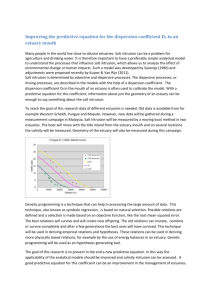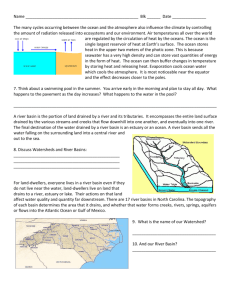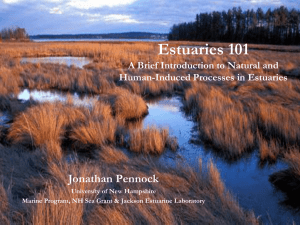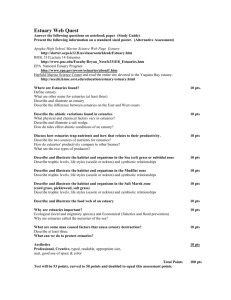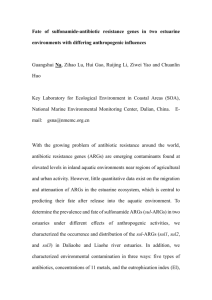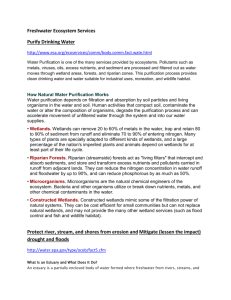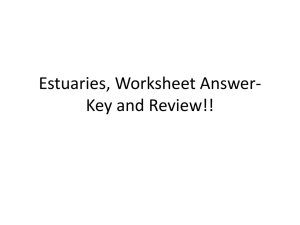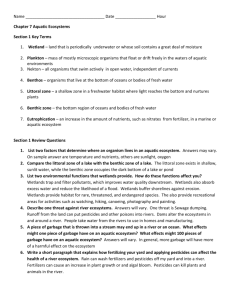us17363 version 41
advertisement
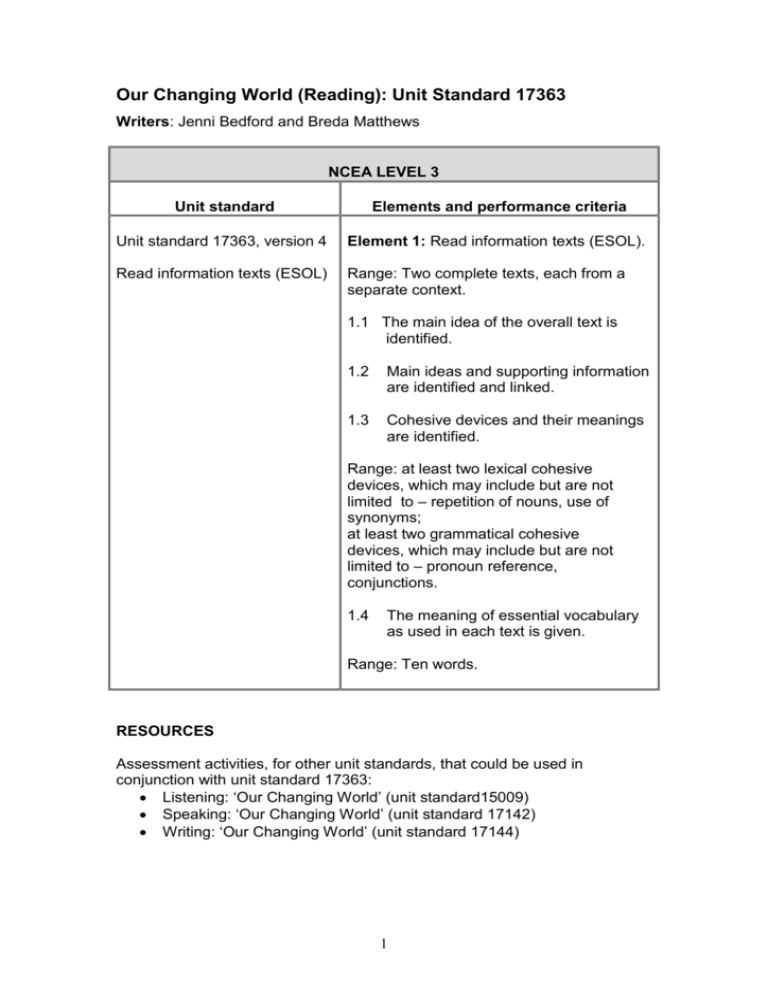
Our Changing World (Reading): Unit Standard 17363 Writers: Jenni Bedford and Breda Matthews NCEA LEVEL 3 Unit standard Elements and performance criteria Unit standard 17363, version 4 Element 1: Read information texts (ESOL). Read information texts (ESOL) Range: Two complete texts, each from a separate context. 1.1 The main idea of the overall text is identified. 1.2 Main ideas and supporting information are identified and linked. 1.3 Cohesive devices and their meanings are identified. Range: at least two lexical cohesive devices, which may include but are not limited to – repetition of nouns, use of synonyms; at least two grammatical cohesive devices, which may include but are not limited to – pronoun reference, conjunctions. 1.4 The meaning of essential vocabulary as used in each text is given. Range: Ten words. RESOURCES Assessment activities, for other unit standards, that could be used in conjunction with unit standard 17363: Listening: ‘Our Changing World’ (unit standard15009) Speaking: ‘Our Changing World’ (unit standard 17142) Writing: ‘Our Changing World’ (unit standard 17144) 1 Teacher sheet: Task 1 Unit standard 17363, version 4 Read information texts (ESOL) Level 3 4 Credits This unit standard has one element: Element 1: Read information texts (ESOL). Range: Two complete texts, each from a separate context. This is ONE of two reading assessments needed to complete this standard. Conditions All assessment activities must be conducted in English, which must not be the student’s first language. Student responses may be oral or written. Written responses need not be grammatically correct, but errors must not interfere with meaning. Students may use an English dictionary but not an electronic translator. Assistance may be given to understand the requirements of the task. Learning contexts Assessment should follow class activities in which the students have had the opportunity to become familiar with the topics through a range of listening, speaking, and writing activities. The question tasks should also be familiar to the students and this can be achieved by including similar question types in the formative work. The English Language Intensive Programme (ELIP) Stage 3, has suggested teaching components, strategies, language features and sample texts on information report genre: ‘Weta’ (2c); The Planets (2d); ‘Athens’ (13c) and ‘The Walrus’ (13d). Notes for Assessors It is important that students are familiar with the requirements of the performance criteria and the special notes. Each of the two texts should be assessed at a different time as part of a wider area of study. Refer to your institution’s policies on resubmissions and reassessment before offering further assessment opportunities. If resubmission takes place, the assessor should ensure that the correct answers are not inadvertently indicated prior to the resubmission opportunity. For example, in a true or false exercise students should redo that part of the assessment task on an unmarked copy. 2 Student instructions: Task 1 Unit standard 17363, version 4 Read information texts (ESOL) Level 3 4 Credits This unit standard has one element: Element 1: Read information texts (ESOL). Range: Two complete texts, each from a separate context. Task 1: The Secret Life of Estuaries Name: ___________________________________________ Date: ____________________________________________ Conditions Do this activity in class. You may ask the teacher to explain the instructions. You may use an English dictionary but not an electronic translator. Your spelling and grammar do not need to be perfect but your teacher needs to be able to understand what you mean. 3 Student checklist: Task 1 In this assessment task you will need to show that you can do the following: Say what you think the main idea of the whole text is. 1.1 Identify the main ideas and supporting information. 1.2 Link the main ideas with the correct supporting information. 1.2 Find examples of lexical and grammatical cohesive devices and explain their meaning. Lexical cohesive devices could include: - word chains e.g. threats to dolphins: trapped, tangled, pollutants, asphyxiated - use of collocations e.g. sea floor, sea life, sea bird Grammatical cohesive devices could include: - pronoun reference e.g. They are the only dolphins with… - conjunctions e.g. Young dolphins usually stick close to their mother or another dolphin. 1.3 Give the meaning of important vocabulary from the text e.g. rare, endangered, protected, species. 1.4 4 Reading text: Task 1 The Secret Life of Estuaries Adapted from a text by Andrew Innes, “The Secret Life of Estuaries” (In Connected 3, 2006, Learning Media, Wellington). On the move Estuaries are parts of bays or harbours where fresh water and seawater meet. A lot of water enters and leaves an estuary. Fresh water enters through rivers and streams, or it can arrive straight over the land. The tide moves in and out of a harbour twice a day. The plants and animals that live there depend on what is dropped off and what is taken away by this moving water. Estuaries absorb waterborne substances from a wide area of land and concentrate them in a small area of water. Fresh water from the land carries lots of soil, detritus (rotting plants and animals), and nutrients. Some of these nutrients move straight through the estuary and out to sea. Most stay in the mud and waters of the estuary. The clean up crew The bacteria and animals that help keep estuaries clean are often called ‘recyclers’. Lugworms and crabs suck up the sediment and digest the remains of plants and animals. Lugworms also put oxygen back into the mud as they burrow 5 through it. Filter-feeders, such as feather-duster worms and cockles, sift the detritus from the water. Healthy mudflats support 2,500 cockles per square metre! Plants grow in the soil and use the nutrients. Bacteria are the main group of organisms that digest detritus. Aerobic (oxygendependent) bacteria use some of the nutrients for their own life processes – but they release many of them back into the mud and water. Then these nutrients are absorbed by plants. When good nutrients go bad If too many nutrients, such as farm fertilisers, come from the land, the estuary can begin to die. Large amounts of nutrients cause seaweed and phytoplankton to grow out of control 6 When the weather gets colder, these plants begin to die. The plants sink and are added to the mud. Aerobic bacteria digest all this food, but eventually they use up all of the dissolved oxygen in the water. Then they, and other animals, die. Anaerobic bacteria take over. Anaerobic bacteria do not need oxygen to live. As the anaerobic bacteria digest the detritus, they turn the sediment black and release toxic and smelly gases, such as hydrogen sulfide. Other living things cannot survive in this environment and the estuary begins to rot. This process is called eutrophication. What happens in a healthy harbour In a healthy harbour solar energy, nutrients and carbon dioxide are absorbed by phytoplankton (microscopic plants) and seaweed. This is the first part of a food chain. 7 Food chains and food webs are simple ways of showing feeding relationships. A food chain is very simple – but the reality is more complicated, with lots of organisms at each level. For this reason ecologists talk about food webs. A food web is made up of many food chains joined together. But estuaries are a little unusual. The living phytoplankton and seaweeds are only a small proportion of the plants consumed by the herbivores. Most of the plant matter at the base of the food web is detritus that has flowed in from the land. It is all this dead plant matter from elsewhere that makes an estuary such a rich environment. Zooplankton, scavenging polychaete worms and other herbivores consume living plants and large amounts of plant detritus. Then these become food for small carnivores such as larger invertebrates and small fish. At the top of this food web, in the open ocean beyond the estuary, are larger carnivores. These include seabirds, large fish and mammals such as seals and people. 8 What is so special about estuaries? Estuaries are essential for many animals and plants. A healthy estuary provides all sorts of habitats in which different plants and animals live. Estuaries are also important breeding grounds. They are sheltered places where immature fish and other young animals hatch and develop before they reach adulthood and move into the open seas. Housekeeping hints for harbours Our activities can upset an estuary ecosystem – but equally, we can be of great help. It is important for us to keep unhealthy chemicals (including fertilisers) and too much damaging soil out of estuaries. It is also important not to “reclaim” land in estuaries. Some of the mud might be dark and smelly, and some of the mangroves swamps and mudflats might seem like wasted space, but they play a very important role in the health of estuaries – and of the entire ocean. 740 words 9 Student sheet: Assessment task 1 Unit standard 17363 version 4 Read information texts (ESOL) Level 3 4 credits Name ………………………………………………… Date………………………… Read the text and answer the questions below. 1. The main idea of the overall text is identified (1.1) What is the main idea of the text? Tick the answer that gives the main idea of the whole text. a. How to get rid of bad nutrients in estuaries b. The importance of estuaries to our ecosystem c. The animals and plants that live in estuaries d. Estuaries and food webs 10 2. Main ideas and supporting information are identified and linked (1.2) Below are some main ideas and supporting information from the text. Choose the correct main ideas and supporting information to fill in the table for Question 2. There is one piece of extra information. a. Too many nutrients cause problems in estuaries. b. Filter feeders sift the detritus from the estuary water. c. They digest detritus in the sediment, put oxygen back into the water and sift detritus out of the water. d. Estuaries are where fresh water and sea water meet. e. Carnivores are at the top of the food web. f. They provide different habitats. They are important breeding grounds. Young animals and fish hatch and live there. g. Human activity can damage estuaries. h. The health of an estuary is important because it can affect our oceans. i. Fresh water carries soil, detritus and nutrients into the estuary. Some of this leaves the estuary and goes out to sea, and some of it stays in the estuary. 11 2. Fill in the table below. An example has been given. Main Ideas Supporting information _____d____ Estuaries are where fresh water and sea water meet. Fresh water travels over land or down rivers and streams. The tide brings sea water in twice a day. Estuaries concentrate water borne substances in a small area. i) ______ ‘Recyclers’ help keep estuaries clean. ii) ______ iii) _________ Seaweed and phytoplankton grow out of control and then die. Aerobic bacteria digest the detritus but use up all the oxygen. Anaerobic bacteria take over. The estuary begins to rot. Estuaries are important for animals and plants. iv) ______ v) _________ by allowing chemicals to get into the water allowing sediment to get into estuaries destroying estuaries by reclaiming the land. 12 3. Cohesive devices and their meanings are identified (1.3) Read this section of the text. The Clean-up Crew 1 Down in the mud of an estuary, lugworms and crabs suck up the 2 sediments and digest the good bits. Also, filter feeders, such as feather 3 duster worms and cockles, sift the detritus from the water. Healthy 4 mudflats support 2500 cockles per square metre. This shows the huge 5 amount of food floating around an estuary. 6 Bacteria are the other main group of organisms that digest detritus. 7 Aerobic (oxygen dependent) bacteria on the sea floor use some of the 8 nutrients for their own life processes –but they release many of them 9 back into the mud and water. These nutrients can then be absorbed 10 again by plants. This is why bacteria and animals that eat detritus are 11 often called “recyclers”. 12 Lugworms help bacteria by oxygenating the mud – but not all bacteria 13 need oxygen. Deep in the sediments, there’s little or no oxygen and this 14 is where the anaerobic bacteria live. (Anaerobic bacteria do not need 15 oxygen for survival. In fact, some are poisoned by it). As anaerobes 16 digest deeply buried detritus, they turn the sediment black and release 17 toxic and smelly gases, such as hydrogen sulfide. 13 3a. Lexical cohesion: Word chains Find words or phrases in the text above that refer to detritus. An example has been given. Words or phrases that are closely linked to detritus e.g. sediments i) …………………………………… ii) ………………………………….. iii) ………………………………….. 3b. Lexical cohesion: Classes and subclasses Fill in the missing words to show you understand class relationships to do with estuary recyclers. Estuary recyclers Class Subclass Bacteria i) ………………………………. Animals lugworms and ii) …………………………….. filter-feeders such as iii) …………………………….. and cockles. 14 3d. Grammatical cohesion: Connectives Find these highlighted words in the text above. Also (line 2) such as (line 2) but (line 8) As (line 15) Which word comes before an example? i)…………………….. Which word tells you something is happening at the same time? ii) …………………… Which word adds a new piece of information? iii)……………………. Which word introduces a contrasting piece of Information? iv) …………………… 3e. Grammatical cohesion: Pronouns Find these highlighted pronouns. What nouns do these words refer to? i) their (line 8) ……………………………………. ii) they (line 8) ……………………………………. iii) them (line 8) ……………………………………. iv) it (line 15) ……………………………………. 15 4. Understanding the vocabulary in the text (1.4) Match the words with their meaning in the text. an invertebrate to concentrate to consume a habitat sediment to recycle to absorb an organism a nutrient an ecologist to reclaim bacteria Word Meaning i) a substance containing minerals that plants or animals need to grow and be healthy ii) a place where a plant of animal lives iii) soil or mud on the bottom of a river or estuary iv) a person who studies the relationship between plants, animals and their environment v) to cause a large number of things to gather in a small area vi) a living plant or animal vii) to eat, drink or use something viii) to make land usable ix) to use something more than once x) to take in a liquid, gas, colour, heat light etc. xi) an animal that does not have a backbone xii) microscopic living organisms Student instructions: Task 2 16 Unit standard 17363, version 4 Read information texts (ESOL) Level 3 4 Credits This unit standard has one element: Element 1: Read information texts (ESOL). Range: Two complete texts, each from a separate context. Task 2: Controlling Animal Pests in New Zealand’ Name: ___________________________________________ Date: ____________________________________________ Conditions Do this activity in class. You may ask the teacher to explain the instructions. You may use an English dictionary but not an electronic translator. Your spelling and grammar do not need to be perfect but your teacher needs to be able to understand what you mean. 17 Student checklist: Task 2 In this assessment task you will need to show that you can do the following: Say what you think the main idea of the whole text is. 1.1 Identify the main ideas and supporting information. 1.2 Link the main ideas with the correct supporting information. 1.2 Find examples of lexical and grammatical cohesive devices and explain their meaning. Lexical cohesive devices could include: - word chains e.g. threats to dolphins: trapped, tangled, pollutants, asphyxiated - use of collocations e.g. sea floor, sea life, sea bird Grammatical cohesive devices could include: - pronoun reference e.g. They are the only dolphins with… - conjunctions e.g. Young dolphins usually stick close to their mother or another dolphin. 1.3 Give the meaning of important vocabulary from the text e.g. rare, endangered, protected, species. 1.4 18 Reading text: Task 2 ‘Controlling Animal Pests in New Zealand’ by Dave Galloway & Richard Gribble (Adapted from e-vibe environmental education newsletter, No.10, May, 2005). New Zealand has a number of non-native animal, bird and insect species that are now considered pests. They affect humans and threaten the environment in a number of ways: Browsing or grazing on native plants or pasture; Competing with our native bird species for territory, food, roost sites; Feeding on our native birds, bats and insects; Spreading diseases, such as bovine tuberculosis; Creating a nuisance in recreational areas. Many of these animal pests have been in New Zealand for a long time and their impact is now well known. It is ironic that most were introduced for beneficial reasons. Twelve species or groups of species are declared pests in the Regional Pest Management strategy. They are: Magpie and Myna; Mustelids: Ferret, Stoat and Weasel; Wasps: Common wasp, Asian paper wasp, Australian paper wasp and German wasp; Wallabies: Darma, Swamp, Brush tailed Rock & Parma; Rats: Norway, Ship and Kiore. 19 For some other animals, for example Eastern Rosella, Sulphur Crested Cockatoo, Spur-winged Plover, Feral Pigs and Rainbow Skinks, we do not know what their impact is or the most effective means of control. In Auckland, the regional council is carrying out research on these animals. The Auckland Regional Council (ARC) mainly does animal control work in areas of high environmental or conservation value. At present most control work is done to prevent damage caused by possums and goats. The ARC also provides assistance, advice and information to Community and Care groups who wish to undertake pest control work. Animals declared as pests in the Regional Pest Management Strategy cannot be bred, sold, given away or exhibited. An Animal control success story Rakino Island in the Hauraki Gulf is a popular holiday destination. It is a very beautiful place with pohutukawa growing along the coastline and cattle grazing the farmland. However, it once had a very bad rat problem. Rats destroy native seedlings, bird’s eggs and chicks and cause a nuisance around people’s homes. In 2002, the Auckland Regional Council, with assistance from the Department of Conservation (DOC) and local residents, decided to remove rats from Rakino Island. They wanted to restore the island’s native plants and animals. Norway rats (Rattus norvegicus) had been controlled in the past but programmes had not always been successful. Anti-poison views, poor coordination, erratic bait replenishment and poor seasonal timing have been some of the reasons for failure. The 2002 programme began in autumn and continued throughout the winter months. It required setting a total of 750 bait stations across the whole of the island on a 50x50 metre grid. Bait stations were also put around the coastal cliffs and on rocks. The common rat bait called Brodifacoum was used. Because of the grass being grazed, any bait stations used in paddocks were 20 buried so that cattle wouldn’t interfere with them. The bait stations were refilled every three weeks until bait take stopped. Getting support from local landowners and providing information is critical for any animal control programme. All landowners on Rakino were contacted, an article was put into the local newsletter and advertising signs were placed around the island. The programme was monitored by DOC in 2003. This was done by using tracking tunnels at 37 key sites across the island. No rats were found which was a fantastic result. Fascinating facts At least 32 species of introduced mammals are living wild in New Zealand Stoats and weasels were introduced in the 1880s to control rabbits (although they quickly spread to forests and became a serious threat to native birds). 1080 is a chemical that is naturally occurring in many Australian plant species where it acts as a defence against possum browsing. There are no possums or mustelids (stoats, weasels or ferrets) on Great Barrier Island. Mice mature at 8 weeks old and then produce litters every 20-30 days. Both deer and goats have strong food preferences, so that even at low density they can eliminate their most favoured food species from a forest. 680 words 21 Student sheet: Assessment task 2 Unit standard 17363, version 4 Read information texts (ESOL) Level 3 4 credits Name ………………………………………………… Date………………………… Read the text and answer the following questions: 1. The main idea of the overall text is identified (1.1) What is the main idea of the text? Tick the answer that gives the main idea of the whole text. a. How rats were successfully controlled on Rakino island b. Interesting facts about animal pests in New Zealand c. The importance of reducing animal pests in New Zealand d. The work of the Department of Conservation 22 2. Main ideas and supporting information are identified and linked (1.2) Below are some main ideas and supporting information from the text. Choose the correct main ideas and supporting information to fill in the table for Question 2. There is one piece of extra information. a. There are several reasons for past failures. These include residents against the use of poisons, ineffective leadership, and the wrong time of the year. b. To make sure an animal programme works, it is very important to get support from local landowners by providing them with information. c. The Auckland Regional Council can also give help to groups who are interested in pest control. d. Their wish was to return the island to how it used to be, with only native plants and animals. e. The Regional Pest Management strategy has published a list of pests. f. The Auckland Regional Council mainly does animal control work in areas where we value and want to protect plants. 23 2. Fill in the table below. An example has been given. Main Ideas ____c__ There are many nonnative animals, birds and insects in New Zealand that are now considered pests. Supporting information These pests can harm humans by spreading diseases and creating a nuisance. They can affect our environment by damaging plants and killing native birds etc. i) ______ They are: Magpie and Myna Mustelids: Ferret, Stoat and Weasel Wasps: Common wasp, Asian paper wasp, Australian paper wasp and German wasp Wallabies: Darma, Swamp, Brush tailed Rock & Parma Rats: Norway, Ship and Kiore ii) _____ At present most control work is done to prevent the damage to plants caused by possums and goats. The Auckland Regional Council, the Department of Conservation and local residents decided to remove rats from Rakino island in 2002. iii) ______ Programmes to remove the iv) ______ Norway rat have not always been successful. v) ______ They did this by making all landowners aware of what was happening through newspaper articles and advertising signs. 24 3. Cohesive devices and their meanings are identified (1.3) Read this section of the text. 1 Rakino Island in the Hauraki Gulf is a popular holiday destination. It is a 2 very beautiful place with pohutukawa growing along the coastline and 3 cattle grazing the farmland. However, it once had a very bad rat problem. 4 Rats destroy native seedlings, bird’s eggs and chicks and cause a 5 nuisance around people’s homes. 6 Norway rats (Rattus norvegicus) had been controlled in the past but 7 programmes had not always been successful. Anti-poison views, poor 8 co-ordination, erratic bait replenishment and poor seasonal timing have 9 been some of the reasons for failure. 10 The 2002 programme began in autumn and continued throughout the 11 winter months. It required setting a total of 750 bait stations across the 12 whole of the island on a 50 x 50 metre grid. Also, bait stations were put 13 around the coastal cliffs and on rocks. 14 Because of the grass being grazed, any bait stations used in paddocks 15 were buried so that cattle wouldn’t interfere with them. 16 The programme was monitored by the Department of Conservation in 17 2003. This was done by using tracking tunnels at 37 key sites across the 18 island. No rats were found which was a fantastic result. 3a. Lexical cohesion: Word chains Word chains are groups of words in a text that are linked in meaning. These word chains give cohesion to text. Which words in the text above are closely linked to ‘Rakino Island’? An example has been given. Rakino Island e.g. coastline i) …………………………………… ii) ………………………………….. iii) ………………………………… 25 3b. Lexical cohesion: Classes and subclasses Fill in the missing words to show you understand class relationships to do with the animals and birds. Class Subclass e.g. bird’s eggs Animals i) ………………………………. ii) ……………………………… iii) …………………………….. 3c. Grammatical cohesion: Pronouns Find the pronouns in bold in the text above and write the noun or phrase they refer to. i) It (line 1) _________________________________ ii) It (line 11) _________________________________ iii) them (line 15) _________________________________ iv) this (line 16) _________________________________ 3d. Grammatical cohesion: Connectives The words underlined in the text above join pieces of information together. as a result as well whereas as a consequence in addition in spite of this consequently another but although Replace the connectives in the text with a suitable word or phrase from the box above. You must make sure it can fit into the sentence in the text. 26 i) however (line 3) ____________________________________ ii) but (line 6) ________________________________________ iii) also (line 12) ______________________________________ iv) because (line 14) ___________________________________ 4. Understanding the vocabulary in the text (1.4) strategies nuisance declared successful monitoring danger ruin re-establish grazed introducing competed impact controls extremely important assist Complete the following sentences by choosing words from the box above that match the meaning (as used in the text) of the words in bold below. You will not need to use all the words and phrases in the box. i) It had a strong _______________ (effect) on the situation. ii) The ARC _______________ (announced) that it would control the listed pests. iii) The pasture and native plants were being _______________ (eaten) by pests. iv) Many _______________ (plans) have been thought up by councils to get rid of pests. v) Councils want to _______________ (help) other organisations in the fight against pests. vi) _______________ (Bringing) opposums into New Zealand from Australia was a very bad idea. vii) DOC was _______________ (checking) how effective the programme was. 27 viii) We don’t know what their impact is, or the most _______________ (effective) means of control. ix) Rats ______________ (destroy) birds’ eggs and chicks. x) They wanted to ______________ (restore) the island’s native plants and animals. xi) Providing information is ______________ (critical) for any animal control programme. xii) Stoats and weasels were introduced in the 1880s and quickly became a serious ______________ (threat) to native birds. 28 Assessment schedule: Task 1 - The Secret Life of Estuaries Unit standard 17363, version 4 Read information texts (ESOL) Level 3 4 credits Element 1: Read independently information texts (ESOL) Range: Two complete texts, each from a separate context. PC Evidence Judgement 1.1 1. Correct answer is: b. The importance of estuaries to our ecosystem. The main idea of the overall text is identified. Answer is correct. 1. 2 2. Correct answers are: i) i - Fresh water carries soil, detritus and nutrients into the estuary. Some of this leaves the estuary and goes out to sea and some of it stays in the estuary. Main ideas and supporting information are identified and linked. 4 out of 5 answers correct ii) c – They digest detritus in the sediment, put oxygen back into the water and sift detritus out of the water. iii) a - Too many nutrients cause problems in estuaries. iv) f They provide different habitats They are important breeding grounds Young animals and fish hatch and live there v) g - Human activity can damage estuaries. 1.3 3a. Lexical cohesion: Word chains i) ii) & iii) Any three of the following: good bits, food, nutrients, mudflats, mud. 3.b. Lexical cohesion: Class and subclass. The following in any order: i) aerobic ii) crabs iii) feather-duster worms 3c. Grammatical cohesion: Connectives i) such as 29 The effect on meaning of lexical and grammatical cohesive devices is demonstrated. 3a. 2 out of 3 answers correct. 3b. 2 out of 3 answers correct. 3c. 3 out of 4 answers ii) as iii) also iv) but correct. 3d. Grammatical cohesion: Pronouns i) aerobic bacteria ii) aerobic bacteria iii) nutrients iv) oxygen 1.4 i) ii) iii) iv) v) vi) vii) viii) ix) x) xi) xii) a nutrient a habitat sediment an ecologist to concentrate an organism to consume to reclaim to recycle to absorb an invertebrate bacteria 3d. 3 out of 4 answers correct Understanding of the meaning of ten items of essential vocabulary as used in the text is demonstrated. 10 out of 12 answers correct. 30 Assessment schedule: Task 2 - Controlling Animal Pests in New Zealand Unit standard 17363, version 4 Read information texts (ESOL) Level 3 4 credits Element 1: Read independently information texts (ESOL) Range: Two complete texts, each from a separate context. PC Evidence Judgement 1.1 1. Correct answer is: c. The importance of reducing animal pests in New Zealand The main idea of the overall text is identified. Answer is correct. 1.2 2. Correct answers are: i) e - The Regional Pest Management strategy has published a list of pests. Main ideas and supporting information are identified and linked. 4 out of 5 answers correct. ii) f – The Auckland Regional Council mainly does animal control work in areas where we value and want to protect plants. iii) d - Their wish was to return the island to how it used to be, with only native plants and animals. iv) a - There are several reasons for past failures. These include residents against the use of poisons, ineffective leadership, and the wrong time of the year. v) b - To make sure an animal programme works, it is very important to get support from local landowners by providing them with information. 1.3 3a. Lexical cohesion: Word chains i) ii) & iii) in any order: popular, destination, beautiful coastal cliffs, farmland, paddocks, grass, coastline, place, the farm, place, Hauraki Gulf, pohutukawa 31 The effect on meaning of lexical and grammatical cohesive devices is demonstrated. 3a. 2 out of 3 answers correct. 3b. Lexical cohesion: Class and subclass i) ii) & iii) in any order: chicks, cattle, rats 3b. 2 out of 3 answers correct. 3c. 3 out of 4 answers correct. 3c. Grammatical cohesion: Answers similar to the following: Pronouns i) Rakino Island ii) The programme iii) The bait stations iv) (The) monitoring (of the programme) 3d. 3 out of 4 answers correct. 3d. Grammatical cohesion: Connectives i) in spite of this or but ii) although iii) as well OR in addition iv) as a result OR as a consequence 1.4 4. i) ii) iii) iv) v) vi) vii) viii) ix) x) xi) xii) Understanding of the meaning of ten items of essential vocabulary is demonstrated. impact declared grazed strategies assist introducing monitoring successful ruin re-establish extremely important danger 10 out of 12 answers correct. 32

